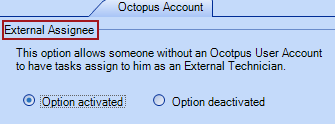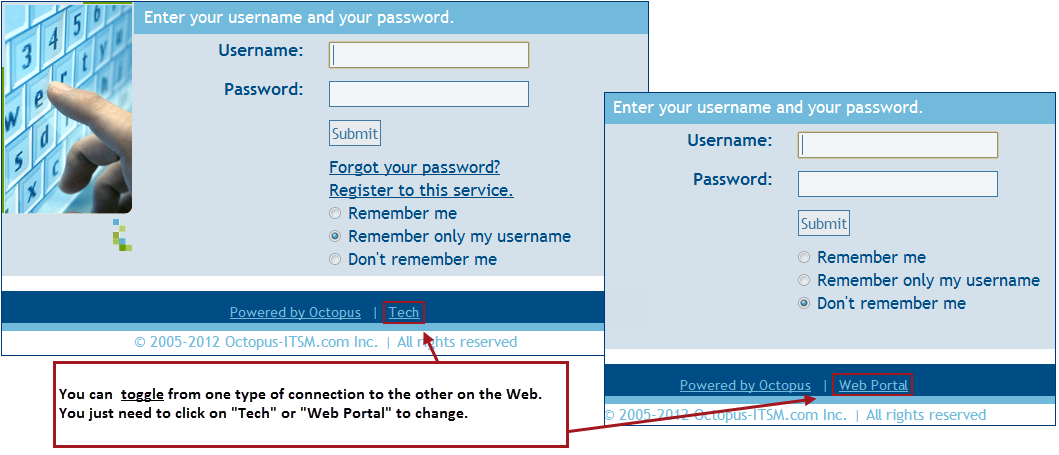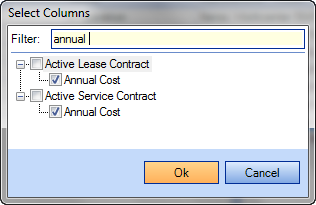
Welcome to the Octopus Fall 2012 version!
The Fall version has many changes, but few have an impact on the existing features. Therefore, its arrival will not require specific planning on your part.
This page contains an overview of the most important changes of the version.
It is Now Possible to Assign Tasks to Users
Collaborative work between departments and services is increasingly important in the overall operations of a company. In IT, we can observe that many requests require people from different departments, that are not part of the Octopus Workgroups, to get involved. Therefore, we have added the possibility to assign tasks to them, so they can participate in the execution of a Service Request.
In Octopus, we identify these users as "External Assignees".
External Assignees:
-
Receive email notifications for new assignments
-
Can access the Tasks Module from the Web Portal, which allow them to :
-
See the list of the New, Assigned, Opened and Completed tasks
-
Take Charge of a task
-
Add an activity in a task
-
Mark a task completed
-
Assignment of tasks to External Assignees is mostly used for Access Management, for instance where the people who create and grant access to applications are not with the IT department (see example below). But there are many other possibilities of using External Assignees, such as harmonizing your New Employee Welcome Process, by sending tasks to:
-
Prepare an access card
-
Request a guided visit of the building with HR
-
Request training on the company politics and processes
-
Etc.
Example :
Martin works for the Sales Department. He is the CRM System Specialist for the company and he administers the user accounts for CRM.
Octopus allows you now to assign a task to Martin for the creation of an account, even if he does not have a formal Octopus Account.

- Configuration : You need to identify the user as an "External Assignee" in his Octopus file (Octopus Account Tab), in order to be able to assign tasks to him and add him to a user group.
- Cost : UAn External Assignee account costs 10.00$/month. Contact us if you need more information.
Please consult the External Assignee - How to use the Tasks article.
Web Portal and WebTech Interfaces
Task Management
Octopus Users can now manage their tasks with the "Tasks" Module, now available in the "WebTech" interface. This enables them to Take Charge, Modify or Complete a task from a station that does not have the Octopus client installed.

Figure 1 - Tasks Module on Web Portal
The supported functions for Tasks on the Web interfaces are:
-
List of Assigned, Opened and Completed tasks
-
Taking Charge of a task
-
Mark a task Completed
-
Add an activity to a task

Figure 2 - Task display in WebTech
Click this link for more information on Tasks Creation.
Toggle
We have made the interface easier for the Octopus Users that go on "WebTech" a lot. Octopus will now remember the last type of connection used (WebTech or Web Portal) by an Octopus User. He can now toggle between types of connection by clicking "Tech" or "Web Portal", at the bottom of the page, in order to connect with the other way.

Adapted to Tablets and Smart Phones
The Web Portal and the WebTech interfaces can now be used on mobile units. The interfaces are a bit different because they change to fit the size of the unit used.

Access Management Solution
The Access Management Solution offers the following benefits:
-
Automated Records of accesses that let you know:
-
For each user: the different system or application accesses used to perform their duties
-
For each system or application: the list of users that have access to them
-
-
Automated Task creation to grant accesses, when a manager submits a "New Employee" or an "Access Change Request" form for one of his employees
-
Automated Task creation to remove accesses, when a manager submits a "Permanent Departure" form for one of his employees
Documentation :
This solution requires the support of an Octopus Specialist due to it's more complex configuration. Moreover, the important impact it has on the Users and the External Assignees must be considered and adapted to your organization's context. Contact us to get more information on the implementation of the Automated Access Management Solution.
Confidential Option for Service Request
It's now possible to mark a service request as confidential. This option, however, is only configurable from a SR Types (not from within the SR itself). It affects the SR Type in the following way:
- Octopus' automated notifications (confirmation, taking charge or resolution email notifications) are sent only to the Requester
- Only the Requester can see the SR on the Web Portal
- External Assignees that are assigned to tasks will not have access to the SR details
For example, this option is useful for managing confidential employee dismissals. When an immediate supervisor submits a "Permanent Departure" form, he is the requester and designates the user in the form. If the SR Type is confidential, the user will not be notified and the request will not appear in his list of requests on the Web Portal. (We can agree that whether a person is leaving by dismissal or voluntarily , there is no added value that the user sees this request.)
See the What is a Confidential Request? article for more information.
Improvements to the Email Template Configuration
It's now easier to configure the email templates:
-
The Window can be maximized
-
The "Rich Text" Tab is now the default
-
The numeric variables like {1} have been replaced by text variables as @Request.Subject
-
F3 lets you insert a variable without having to type its name, which is sometimes complex
-
An HTLM editing mode has been added, that will give you more control on the customization of the email templates
- Support for the "Plain Text" will soon be removed.
- When Octopus was first released, some of our customers were using a version of Lotus Notes that was not compatible with Rich Text Format (HTML). Since this is no longer the case, as the recent versions of Lotus Notes are compatible, we will be removing this option.
- If you are still using "Plain Text", please Contact us to plan with us your migration to "Rich Text"..
Please consult the How to Configure the Email Templates article, that explains the different configuration methods that can be used with email templates.
New Action "Change Web Portal Password"
You can now change the Web Portal password for a user within Octopus. This action can also create the Web account for a user that has not subscribed.
To do this, open the user's file and click on "Change Web Portal password".

Consult the Web Portal - How to Reset a User's Password article. It gives step by step instructions to do a reset.
"Requester" Field Added to the Incident Creation Window
When an incident/SR is created from Octopus, you can specify the requester directly. Octopus will automatically add the same name in the user field, for instance where the requester and user are the same, and if it's not the case, the user field can be modified.

This way, when a user submits a request via the Web Portal, he will automatically be the requester (and can change the user if he is submitting the request for someone else).

Service and Lease Contracts - "Cost Center" field and "Note" Tab Added
We have added the following the the Service and Lease contracts:

We have also create a column for "Annual Cost" that can be added to your lists. There is one for Service Contracts and one for Lease Contracts, as you can see below.


In both cases, the column will be called "Annual Cost" but it will give the results of either the Serviceor the Lease contracts. If you require both, you will need to add both columns.
The Annual Cost is calculated as follows:
- Total cost of contract, divided by the number of months between the start and end date, multiplied by 12
- (Total Cost / Duration in months) * 12
- For example, a 2,000.00$ contract set for 18 months, would have an Annual Cost of 1 333,33$.
Other Changes
-
Identification of the "Average Hourly Rate of Ressources" by group, from the Reference Data Management;
-
The "Modify an activity" permission has been renamed "Create and modify an activity";
-
The "Modify Location and Main Contact" permission has been renamed "Modify Location, Main Contact and Category";
-
No notifications will be sent by the "New activity added to an unassigned request/task" event, for a request closed by the user or for the automatic closure of a request;
-
When you do F5 in a list with collapsed groups, they will stay collapsed;
-
You can filter by "Site";
-
Language is now an available column for the Users lists;
-
Follow-up tasks are now a check box called "Does not participate in the Request Life Cycle". It's now possible to tag an approval task as a follow up task;
-
Quick Search Performance: In the "Incident/SR" module, a quick search of a number concentrates the search to only the request number table. If you add the "+" sign, the system will do the search and exclude the request number table;
-
If an Assignee places the Tasks on hold when a SR is suspended or placed on hold, the "hold" gets removed automatically when the SR is taken in charge again.
Thank you, your message has been sent.
